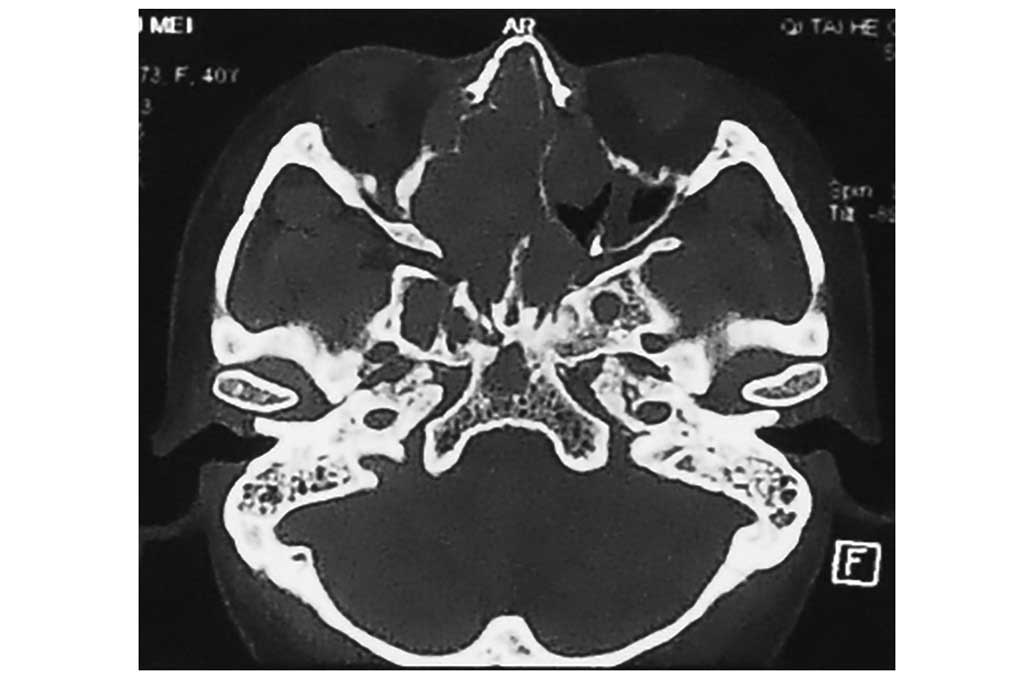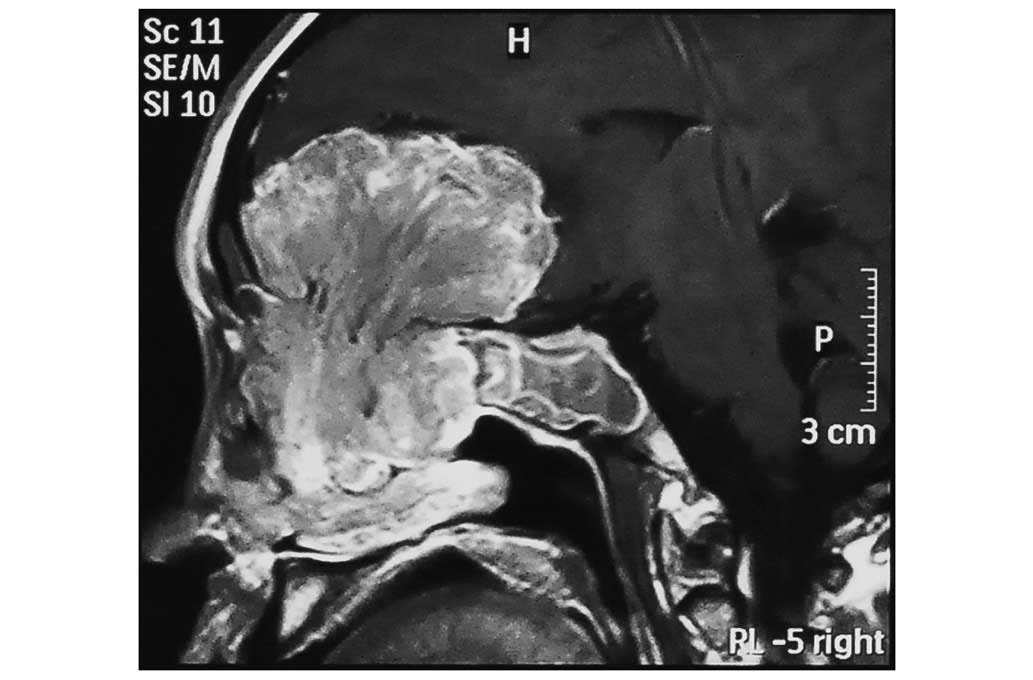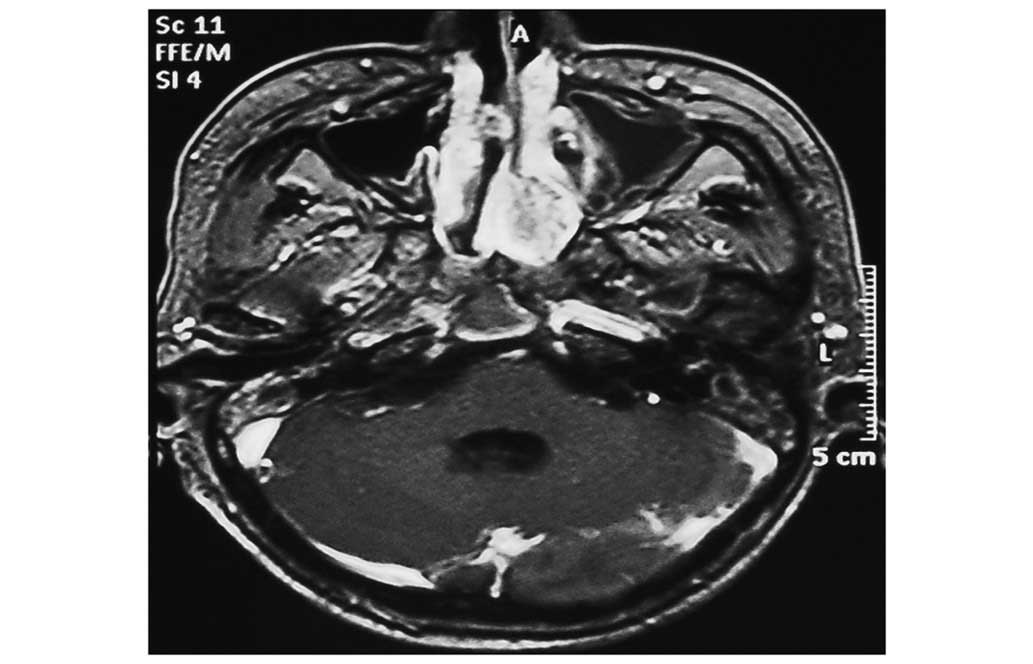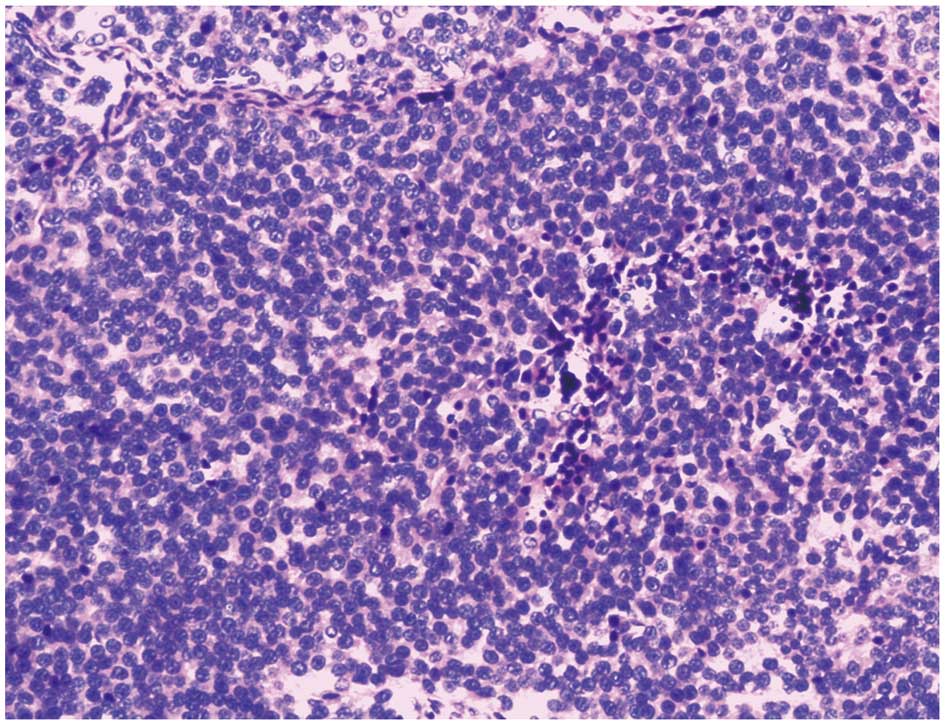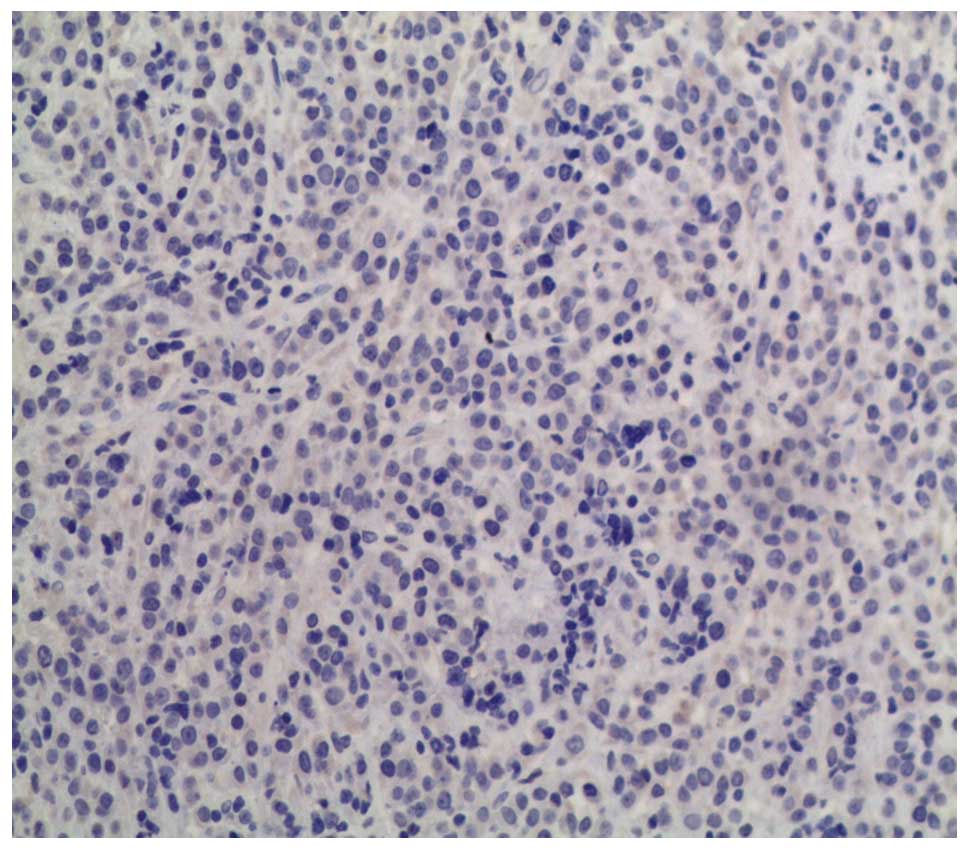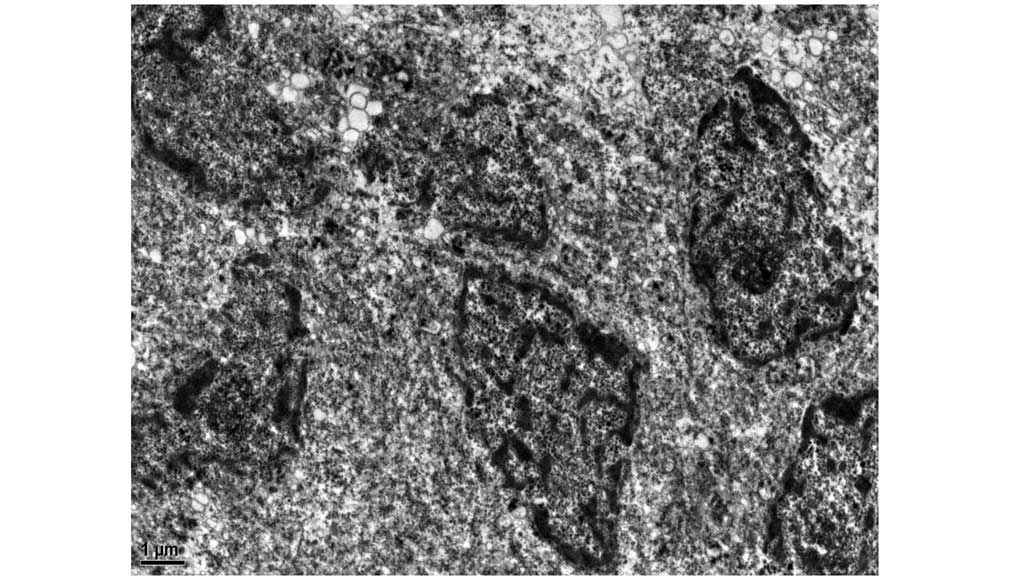Primary intracranial neuroendocrine tumor with ectopic adrenocorticotropic hormone syndrome: A rare and complicated case report and literature review
- Authors:
- Published online on: May 11, 2016 https://doi.org/10.3892/mco.2016.904
- Pages: 99-102
Abstract
Introduction
Neuroendocrine tumors (NETs) originate from the diffuse neuroendocrine system, which is composed of cells functioning as neurocytes, as well as endocrine cells. This type of tumor most commonly occurs in the respiratory system and gastrointestinal tract, while intracranial origin is rare (0.74%). We herein present a case of a 40-year-old woman with a primary intracranial NET, which was immunonegative for adrenocorticotropic hormone (ACTH), resulting in ectopic ACTH syndrome.
Case report
A 40-year-old woman was admitted to Sanbo Brain Hospital (Beijing, China) with a 6-year history of intermittent bilateral rhinorrhea, a 2-month history of rapid weight gain, polydipsia, polyuria and weakness, and a 2-week history of dimness. On examination, the patient was found to have hypertension, dimness, bilateral exophthalmus, diminution of vision in the left eye, pigmentation of the skin of the face and trunk and grade 4 muscle weakness; other findings were unremarkable. Computed tomography (CT) and magnetic resonance imaging scans revealed a sizeable contrast-enhanced tumor in the anterior cranial fossa, which infiltrated the sphenoid and ethmoid sinuses bilaterally, the left maxillary sinus and the nasal cavity (Figs. 1–4). The abdominal CT scans revealed bilateral adrenal hyperplasia. On laboratory biochemical tests, the serum potassium level was 1.92–2.82 mmol/l and the fasting blood glucose (FBG) level 14.9–20.0 mmol/l. The basal ACTH level was 33.72 pmol/l (normal, <2.2 pmol/l), the 6 a.m. serum cortisol level was 1,779.78 nmol/l (normal, 83–359 nmol/l), the 24-h urinary free cortisol level was ≤11,194.64 nmol/24 h (normal, 53.2–789.4 nmol/24 h), and the testosterone level was 8.43 nmol/l (normal, 0.17–2.53 nmol/l).
The provisional diagnosis was anterior cranial base tumor with ectopic ACTH syndrome. The neoplasm was exposed intradurally and extradurally through a right frontal craniotomy, while anterior skull base reconstruction was performed during surgery. The intracranial surgery achieved gross removal of the tumor; however, part of the tumor remained in the nasal cavity (Fig. 5).
The histological examination revealed that the tumor was composed of small round cells with uniform nuclei and scant cytoplasm (Fig. 6). Immunohistochemically, the cells were positive for epithelial markers, including cytokeratin (CK)8, CK18 and cytokeratin A (endo A), and for neuroendocrine differentiation markers, including synaptophysin (Syn), chromogranin A (ChrA), and neuron-specific enolase, but negative for carcinoembryonic antigen, epithelial membrane antigen, thyroid transcription factor 1 and ACTH (Figs. 7 and 8). The Ki-67 labeling index was <1%. Electron microscopy revealed the presence of occasional neuroendocrine granules (NEGs) (Fig. 9). These findings suggested low-grade small-cell NET.
The postoperative course was relatively uneventful. Abdominal CT scans revealed bilateral regression of the adrenal gland hyperplasia and the biochemical results revealed a potassium level of 4.25 mmol/l, FBG level of 6.2–6.5 mmol/l, basal ACTH level of 1.42 pmol/l and 6 a.m. serum cortisol level of 272 nmol/l.
Discussion
NETs originate from amine precursor uptake and decarboxylation cells, which are referred to as the diffuse neuroendocrine system (1–3), whereas intracranial origin is rare (0.74%) (4). To the best of our knowledge, this is the first case of primary intracranial NET, immunonegative for ACTH, resulting in Cushing's syndrome. In biochemical measurements, ChrA may be used as a tumor marker, as it increases in 70–90% of patients with NETs (5). On histological examination, the tumor is composed of large cells with uniform nuclei, scant cytoplasm, basophil granules and irregular mitoses (6). ChrA and Syn are selected as common immunohistochemical markers, which are sensitive and non-specific (7). According to the recent literature, testing for peptide hormones and bioamines is no longer recommended, as no correlation has been confirmed between hormone levels and clinical presentation, and the level of hormone is not a valuable prognostic indicator (8). The presence of intracytoplasmic NEGs on electron micrographs, whose compact cores show high electron density, is of value in the differential diagnosis.
Immunohistochemistry is a significant differential approach to the diagnosis of the neuroendocrine component, epithelial component and detection of neuropeptides. In this case, the tumor had to be differentiated from esthesioneuroblastoma and neuroendocrine carcinoma of the nasal cavity and paranasal sinuses. Klimstra (6) reported that esthesioneuroblstoma was composed of neuroblasts with uniform circular nuclei and longitudinal cerebromedullary tubes in the dendrites. NETs mainly originate from the epithelium, lacking a neural component. Immunohistochemistry of neuroendocrine carcinoma of the nasal cavity and paranasal sinuses is similar to that of the intracranial counterpart, but the Ki-67 labeling index is often >3%. As determined by imaging in this case, the bulk of tumor situated intracranially, with the skull base limiting tumor growth.
The NEGs were rare and immunohistochemistry was negative for ACTH, contradicting the preoperative changes in the serum ACTH level. The main reasons were as follows: i) ACTH consists of 39 amino acids, and is divided into the bioactive part, located in the first 24 amino acid residues, and the immunoactive part, located between the 22nd and 39th amino acid residues (9). Thus, the antibody used in the Pathology Department of our institute may not recognize the secreted hormone. ii) Ectopic tumors may secrete ACTH or an ACTH analogue and a simple anti-ACTH antibody is insufficient for detecting ectopic secretion. iii) Some lesions may secrete ACTH and corticotropin-releasing hormone (CRH) simultaneously (10). Moreover, Al-Gahtany et al (11) reported three cases of ectopic CRH tumors, with pituitary hyperplasia leading to high corticotrophin hyperlipidemia; they also reported that, postoperatively, the ACTH level immediately returned to normal if the tumor produced ACTH, but it decreased gradually if the tumor produced CRH. This patient's postoperative ACTH level returned to normal after 16 days. iv) The tumor had been present for 6 years, but Cushing's syndrome had been present for 2 months. During a follow-up of ~6 months due to the residual tumor in the nasal cavity, the patient did not present with signs or symptoms of hypercortisolism. The reason may be that the ectopic hormone secretion by the residual NET was not sufficient to cause typical Cushing's syndrome.
The optimal treatment of NETs is surgical resection. Patients who receive comprehensive treatment, including completion of chemoradiotherapy, are expected to have longer tumor-free survival, compared with those receiving surgery alone (10). Drugs focusing on the epithelial component may also be selected.
Anterior skull base reconstruction was performed during surgery in this case. It was previously suggested that bony reconstruction should be performed when the deficit is >3 cm (12). The ‘sandwich’ technique is currently used, involving tight suturing of the galea aponeurotica or temporalis fascia and the skull base dura, bony rehabilitation and covering with periosteum.
In summary, to the best of our knowledge, this is the first case of primary intracranial NET with Cushing's syndrome. The tumor was immunonegative for ACTH and may have displayed ectopic secretion of CRH, or an ACTH analogue. The ‘sandwich’ skull base reconstruction technique was performed, using the quadriceps femoris, plastic skull flaps and periosteum, following tumor removal.
References
|
Godwin JD II: Carcinoid tumors. A analysis of 2837 cases. Cancer. 36:560–569. 1975. View Article : Google Scholar : PubMed/NCBI | |
|
Volante M, Rindi G and Papotti M: The grey zone between pure (neuro)endocrine and non-(neuro)endocrine tumors: A comment on concepts and classification of mixed exocrine-endocrine neoplasms. Virchows Arch. 449:499–506. 2006. View Article : Google Scholar : PubMed/NCBI | |
|
Shi J, Xu Z, Wang ZD, et al: Pathological category and diagnosis of neuroendocrine tumor in non-neuroendocrine system. J Clin Exp Pathol. 25:548–550. 2009.(In Chinese). | |
|
Faggiano A, Mansueto G, Ferolla P, Milone F, del Basso de Caro ML, Lombardi G, Colao A and De Rosa G: Diagnosis and prognostic implication of the World Health Organization classification of neuroendocrine tumors. J Endocrinol Invest. 31:216–223. 2008. View Article : Google Scholar : PubMed/NCBI | |
|
Lambert SW, Hofland LJ and Nobels FR: Neuroendocrine tumor markers. Front Neuroendocrinol. 22:309–339. 2001. View Article : Google Scholar : PubMed/NCBI | |
|
Klimstra DS: Pathology reporting of neuroendocrine tumors: Essential elements for accurate diagnosis, classification and staging. Semin Oncol. 40:23–36. 2013. View Article : Google Scholar : PubMed/NCBI | |
|
Travis WD, Rush W, Flieder DB, Falk R, Fleming MV, Gal AA and Koss MN: Survival analysis of 200 pulmonary neuroendocrine tumors with classification of criteria for atypical carcinoid and its separation from typical carcinoid. Am J Surg Pathol. 22:934–944. 1998. View Article : Google Scholar : PubMed/NCBI | |
|
Hochwald SN, Zee S, Conlon KC, Colleoni R, Louie O, Brennan MF and Klimstra DS: Prognostic factors in pancreatic endocrine neoplasms: An analysis of 136 cases with a proposal for low-grade and intermediate-grade groups. J Clin Oncol. 20:2633–2642. 2002. View Article : Google Scholar : PubMed/NCBI | |
|
Smith EM, Galin FS, LeBoeuf RD, Coppenhaver DH, Harbour DV and Blalock JE: Nucleotide and amino acid sequence of lymphocyte-derived corticotropin: Endotoxin induction of a truncated peptide. Pro Natl Sci USA. 87:1057–1064. 1990. View Article : Google Scholar | |
|
Kolesnikova GS, Lapshina AM, Voronkova IA, Marova EI, Arapova SD, Goncharov NP and Dedov II: Comparative analysis of clinical, hormonal and morphological studies in patients with neuroendocrine ACTH-producing tumors. Int J Endocrinol. 2013:6592322013. View Article : Google Scholar : PubMed/NCBI | |
|
Al-Gahtany M, Horvath E and Kovacs K: Pituitary hyperplasia. Hormones (Athens). 2:149–158. 2003. View Article : Google Scholar : PubMed/NCBI | |
|
Liu H, Zhang Q and Yang Z: Skull base reconstruction and rehabilitation. J Clin Otorhinolaryngol. 18:755–757. 2003.(In Chinese). |



